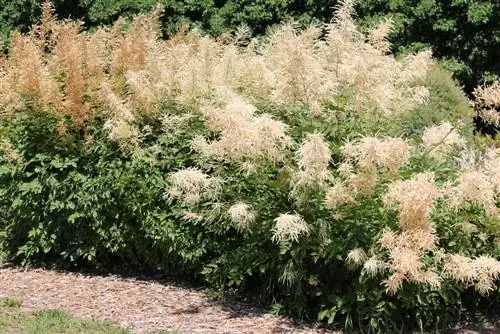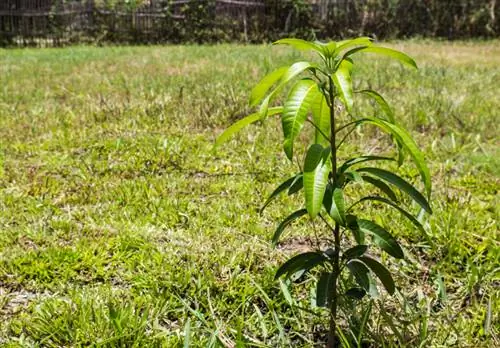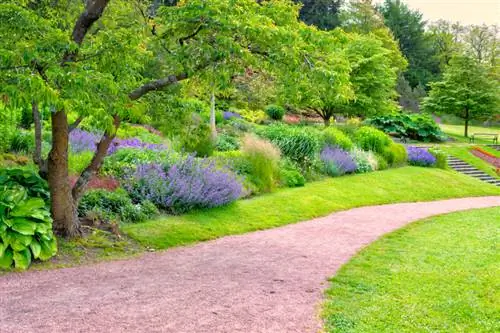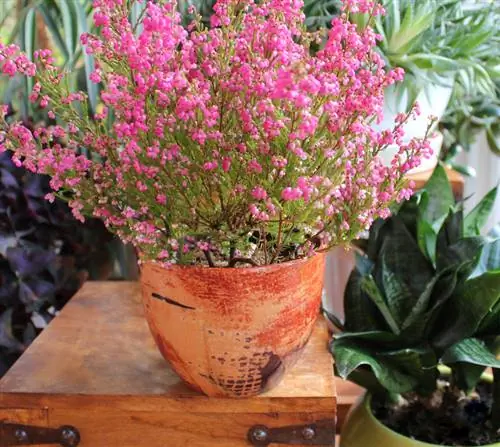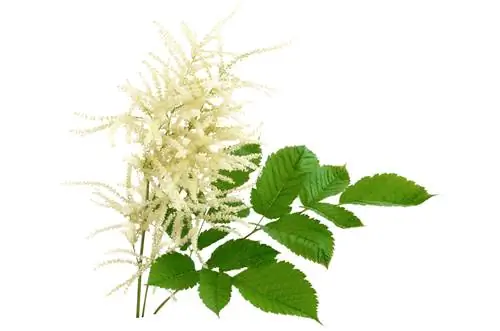- Author admin [email protected].
- Public 2023-12-16 16:46.
- Last modified 2025-01-23 11:21.
When you think of the forest goat's beard, it doesn't occur to you that the forest perennial could be related to cinquefoil, strawberries or roses. The rose family has special requirements for the location. If the conditions are not right, the forest goat's beard cannot thrive.
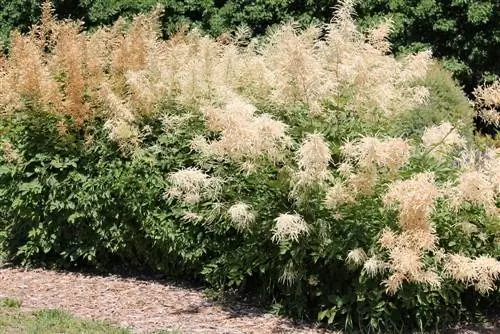
What is the forest goat's beard and when does it bloom?
The forest goat's beard (Aruncus dioicus) is a hardy rose plant that thrives in shady, moist locations and can grow between 80 and 200 cm high. From June to July it produces attractive, hanging inflorescences that attract insects and vary in color from pure white to creamy white.
Origin
Behind the forest goat's beard there is a rose plant with the scientific name Aruncus dioicus. The plant is often offered under the synonym Aruncus sylvestris. This species name indicates its distribution in forests. The species, which is often confused with meadowsweet, occurs in Central Europe. In many places in northern Germany he is a garden refugee. In the Alps, the forest goat's beard conquers altitudes of up to 1,500 meters.
Typical habitats:
- Mixed forests with beech and fir trees
- Maple-ash deciduous forests
- pure beech forests
- Embankments and stream banks
- Canyons
Growth
The rose family is a perennial and herbaceous plant with an underground rhizome that is short and strongly developed. The forest goat's beard overwinters with the help of the rhizome. It is also used for vegetative propagation, so that the plant forms large populations within a short period of time. The above-ground stems are unbranched and often woody at the base. With the inflorescence, the forest goat's beard can grow between 80 and 200 centimeters high. If the site conditions are optimal, the sprawling plant will live for several decades.
leaves
The leaves are stalked and consist of a two- to three-pinnate blade, with the individual leaflets also appearing in three to five parts. Each leaflet is irregularly sharply serrated and tapering. The leaves grow up to 100 centimeters long and are initially fresh green and later dark green in color. The plant is deciduous and dies in winter.
Bloom
Aruncus dioicus develops up to 10,000 tiny individual flowers that are arranged together in terminal inflorescences. From a botanical point of view, they represent disc flowers. The entire inflorescence is made up of many annual partial inflorescences. It reaches a length of between 20 and 30 centimeters and slopes towards the ground. The plants are unisexual.
Flowering time
The forest goat's beard blooms between June and July. The overhanging inflorescences vary in color. While the female flowers are pure white, the male flowers are creamy white. The forest goat's beard sets decorative accents in the garden during the flowering period and acts as a magnet for butterflies, wild bees and bumblebees. Even after the flowering period, the withered inflorescences are an eye-catcher because the flowers retain their light color and do not turn brown.
Fruit
Seeds are only formed when male and female plants grow in one location. Between September and October, the forest goat's beard bears numerous follicles, each containing three to five seeds. The fruits dry out and crack, so the seeds are scattered and spread by wind and water. The seeds are cold germinators that sprout after winter. As a winter keeper, the fruits remain until the next spring. They provide a valuable retreat for overwintering insects and serve as an important source of food for smaller songbirds
Usage
The forest goat's beard is an aesthetic component in the natural wild garden. It enriches butterfly meadows and bee pastures. Due to its impressive height, the rose plant can be optimally planted as a privacy screen. It beautifies the edges of water bodies or trees. Aruncus dioicus can be planted in small groups outdoors, although a rhizome barrier is recommended. In the front garden, the plant acts as a decorative eye-catcher.
These are ideal planting partners:
- tall forest grasses such as pipe grass or turf grass
- Carex species such as Japanese sedge and giant sedge
- Forest bellflower and foxglove
Is forest goat's beard poisonous?
The forest goat's beard contains hydrogen cyanide, which can cause mild poisoning if consumed in large quantities. In northern Italy, the young shoots are offered on the market as vegetables. They are eaten raw or cooked because of their asparagus-like aroma. This is how the plant got its nickname “forest asparagus”. After cooking, the hydrogen cyanide glycosides break down.
Which location is suitable?
Aruncus dioicus grows in shade or partial shade. A place in the shade is also ideal so that the perennial is not permanently exposed to the sun. High humidity ensures he althy growth.
What soil does the plant need?
The sunnier the location, the moister the soil must be. The forest goat's beard requires moist and humus-rich soil. A nutrient-rich and freshly soaked gauze soil with a loose structure is ideal. The substrate may be rich in bases and low in lime.
Propagate forest goat's beard
The forest goat's beard is propagated vegetatively by dividing the rhizome. This measure takes place in autumn or spring before the new growth phase begins. Division can be easily carried out on young plants. The older the plants get, the more difficult they are to divide because of the woody base.
Sowing
Old and young plants can easily be propagated from seeds. To do this, cut off the flower stems in autumn and place them in a container to dry. If the fruit shell tears open, the tiny seeds can be shaken out.
Growing outdoors is very easy. Scatter the seeds over the desired area. A distance of ten to 15 centimeters between the seeds is ideal. To make sowing easier, you can mix the seeds with sand and spread them widely over the area. Wait until next spring. The temperatures provide the required cold stimulus, which has to be done artificially when grown indoors.
What is the best time to plant?
The forest goat's beard can be planted out in late summer. In the first winter, young plants should be protected from the cold. Alternatively, you can plant the perennial in spring. Then the perennial has enough time to develop many roots until winter.
The correct planting distance
In a solitary position, one plant per 100 square meters is sufficient. The plant comes into its own better in small tuffs. You should pay attention to the increase in width of the respective variety. Also maintain a distance of 100 centimeters from other plants. In order to create a dense privacy screen within a short period of time, you should plant three to four plants next to each other per meter. Two plants are enough. However, it takes a little longer for the perennials to develop an opaque green wall.
Forest goat's beard in a pot
The forest goat's beard also thrives in the appropriately large pot if the site conditions are right. The pot must have drainage holes so that irrigation water can drain away. As a container plant, the rose plant needs to be watered regularly because the substrate dries out more quickly. A location in partial shade or shade is necessary for he althy growth.
Watering goat's beard in the forest
The underground root system must not dry out, as the forest goat's beard quickly drops its leaves. The water is stored well in the heavy but loose clay soil with sand content. Aruncus dioicus can also survive shorter dry periods. If there is no rain for a long time, you will have to use the watering can more often. A temporarily flooded soil does not cause any problems for the perennial.
Fertilize forest goat's beard properly
The forest goat's beard prefers more nutrient-rich conditions and enjoys a compost addition in spring. This supplies the plant with all the important nutrients for the growth phase. In autumn you can mulch the soil. As the material decomposes during the winter, the plant benefits from additional nutrients.
Cutting the forest goat's beard correctly
Cutting measures are not necessary as the forest goat's beard does not grow out of shape. The stocks become more abundant and larger over the years. Only the willingness to spread could become a danger if space is limited. If you want to prevent self-propagation, you should cut off spent inflorescences in autumn. In spring, the plant is cut back close to the ground so that the fresh shoots get enough light to grow.
How do I transplant correctly?
The perennial is difficult to transplant when it gets old, which is why you should choose the location carefully before planting. Division is also becoming increasingly difficult because of the woody stems and rhizomes. Divide and rejuvenate the plant in good time to save yourself the effort of transplanting.
hardy
The forest goat's beard is one of the hardy perennials that can easily survive frosty temperatures. The rhizomes are well protected from frost in the ground. If you spread a layer of mulch over the substrate in autumn, the rhizome will be well insulated even in months without snow. The dead plant parts also provide protection from the cold and should therefore be left over the winter.
How to overwinter potted plants:
- in a protected place in the shade
- on a wooden block
- Wrap the container with foil
- Cover the substrate with brushwood
- water on frost-free days
Diseases
The perennial has proven to be resistant to pathogens. It is spared from pests and even appears uninteresting to snails.
Brown leaves
Brown spots on the leaves can have various causes. A change of location or transport in hot weather is often responsible. The plants react sensitively to a rapid change between rain and sun. Raindrops on the leaves act like lenses and cause sunburn. Fungal infestation or pests can also cause stains, although these causes are very rarely an issue.
Forest goat's beard is not blooming
If the perennial was planted in autumn, it invests its energy in root formation. It often happens that the forest goat's beard does not produce flowers the next spring. Only when the plant has settled in well can it put its energy into flowering.
Tip
Place the forest goat's beard right next to a pink flowering spar. The astilbes look very similar to the rose family and ensure a harmonious overall picture. They belong to the saxifrage family and are therefore not closely related to the forest goat's beard.
Varieties
- Kneiffii: Stem wiry. Variety with star-shaped flowers in feather-like panicles, creamy white. Up to 100 centimeters high and 50 centimeters wide.
- Whirlwind: Sterile variety. Panicle-shaped flowers are creamy white, from June to July. Between 100 and 140 centimeters high.

